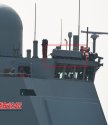There's also the Ford's and 055's dual band radar.
I also want to add the use of the term DBR or Dual Band Radar is quite misleading because SPY-3 and SPY-4 are two separate radars, SPY-3 with the X-band and SPY-4 with the S-band. These are not dual band in the same sense as the Type 346 that emits two spectrum bands right on the same face. Its dual band because you have two separate radars each with their own separate band.
The main array of SPY-6, which succeeds both SPY-3 and SPY-4, is S-band only. The X-band is provided by a dual faced slotted array called SPQ-9B. See the picture here.
What is SPQ-9B
SPQ-9B equips many USN ships like some Nimitz class and some Ticos and will be featured on the Flight III AB. Flight III Burke still has SPG-62 dishes for illumination and targeting, even with SPY-6. In the future, something else may replace the SPQ-9B. But they are not talking about the SPY-3 anymore which means something will replace that too.
By what definition is the Type 346B on the 055 dual band? Is it because it emits two bands on the same face? Or its single band, with the X-band provided by the arrays on the mast, which then makes it dual band? There are also arrays on top of the bridge, and these might be C-band used for surface search, which makes it a triple band?
This DBR thing is marketing lingo, otherwise, what would you call the combined radar sets on the Type 052D? You have the Type 346A providing S (and C) band, with the Type 364 on the mast providing C-band, the Type 344 and Type 366 radars on top of the bridge providing X-band.


